

Ultimate Guide of Common Filter Machine in Mining
2019-06-07 16:17:14xinhai
Filter machine is a dewatering equipment that used to the mineral filtration process, such as filter press, vacuum filter, etc.
Filtration is an effective method for solid - liquid separation. The essence is to use the differential pressure to make the slurry pass through a porous medium layer (spacer layer) that is permeable to water but impervious to solid particles. Therefore, the basic principle of filtration is to use a substance with many pores (such as press cloth) as a medium (called filtration medium), so that the liquid in the pulp passes through the fine gas holes, while the solid particles in the pulp are trapped in the medium. When filtering, the suspension of the filter is usually called filter slurry, the solid particles trapped and accumulated in the filter medium are called filter residue or filter cake, and the liquid passing through the filter cake and filter medium is called filtrate.
Filter machine is a kind of dewatering equipment that used to the mineral filtration process, such as filter press, vacuum filter,etc.
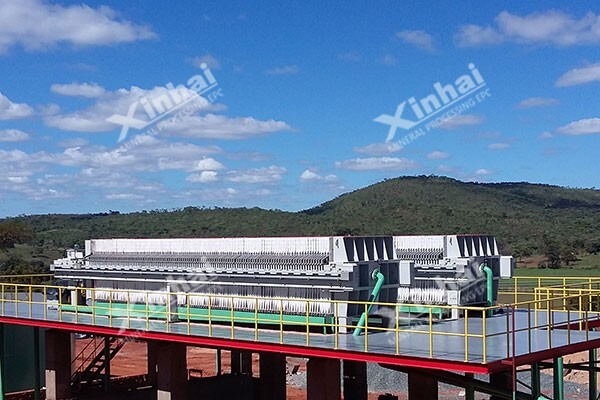
In general, filtration process is the process of separating solid particles from a fluid by using a barrier formed by a porous medium. Under the action of the driving force, the fluid containing the solid particles is forced to pass through the porous medium, while the solid particles are trapped on the medium, thereby achieving the separation of the fluid and the solid particles. Therefore, the physical essence of the filtration is the flow process that the fluid runs through the porous medium and the bed of particles.
The basic component used in the filtration process is a filter medium with superfine channels. The mixture to be separated is placed on one side of the filter medium, and under the action of the fluid driving force, the fluid flows through the pores of the filter medium to the other side of the medium, and the particles are trapped by the medium, thereby achieving separation of the fluid and the particles.
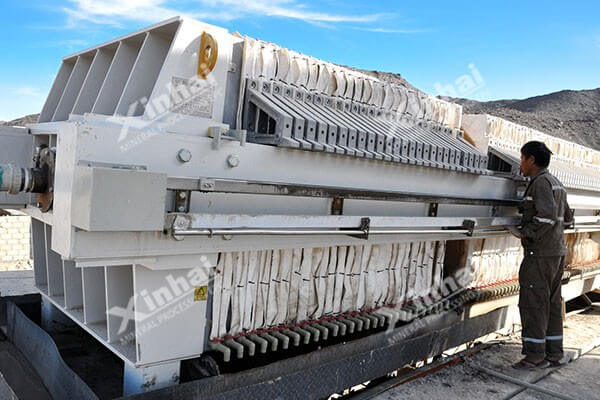
The basic parameters characterizing the properties of the filter cake are: porosity, moisture content, saturation, compressibility and specific resistance.
The wet content of the filter cake refers to the ratio of the liquid mass to the dry solid mass in the filter cake;
Filter cake moisture refers to the ratio of the liquid mass in the filter cake to the total mass of the wet filter;
Filter cake saturation refers to the ratio of the mass of the liquid in the filter cake to the density of the liquid in the filter cake and the total pore volume in the cake filter;
The filter cake porosity refers to the ratio of the total pore volume in the filter cake to the total volume of the filter cake.
Although the forms of cake filtration vary,they share the same characteristic of simultaneous filtration and sedimentation. From the perspective of seepage theory, the difference between the seepage problem and the single sedimentation-deposition process is:
1. The bottom of the sediment layer is a porous medium plate, and the liquid is discharged through the medium plate;
2. There is a large differential pressure across the suspension and filter cake.
When filtering, the solid and liquid phases in the suspension move to the surface of the filter medium under the action of gravity, pressure (or suction caused by vacuum) and shear force caused by liquid viscosity. When the particles settle in the moving fluid, they are subjected to the pressure, resistance, buoyancy, drag and acceleration forces of the fluid. Under the combined action of these forces, the particles in the filter machines rapidly deposit on the surface of the medium to form a filter cake.
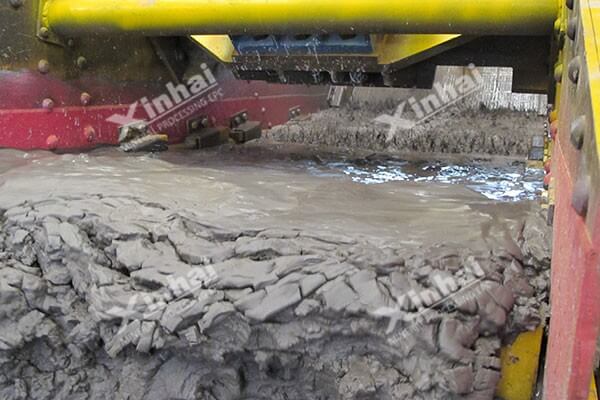
The filtration medium is the bearer of the filter cake. Filtration media all have some traits in common.Firstly, the fluid resistance is small, so there is no need to put much energy to complete the filtration separation; secondly, the pores are not easily blocked by the separated particles. Besides, the speed cake on the filtration media is easy to peel off.
In general, the filter media should have the following characteristics:
1. Porosity. The filtration medium can make liquid flow through and intercept the particles to be separated;
2. Chemical stability, such as corrosion resistance, heat resistance, etc.;
3. Sufficient mechanical strength and long service life.
The commonly used filtration media are as follows:
1. Fabric media. It includes fabrics made of natural fiber such as cotton, wool, and silk and synthetic fibers, as well as nets woven from metal wires. The sizes of solid particles that fabric media can trap range from 5 to 65 um.
2. Stacking media. This kind of media formed by heaping fine and hard particles such as fine sand, charcoal,asbestos, or non-woven fibers. They are mostly used for deep bed filtration.
3. Porous solid medium. They are made of solid materials with micro channel, like porous ceramics, porous plastic, and porous metal, suitable for intercepting fine particles of 1 to 3 μm or more.
4. Porous membrane. This kind of media is made of polymer material, with the characteristics of thin film and fine pores.The smallest particles they can separate is 0.005 um, so they are mostly used in ultra filtration and micro filtration processes.
According to the different filtration mechanism, the common filtering methods are generally divided two types: filter cake filtration and deep bed filtration.
1. Filter Cake Filtration
Filter cake filtration often use fabric,porous solid or pore film as filter media. The pore size of the media is generally smaller than that of the particles. When filtering, the fluid can pass through the small pores of the media, while the large-sized particles cannot enter the small pores and are trapped by the filter media to form a filter cake.Therefore, the retention of particles mainly depends on the screening.
The filter cake is formed on the surface of the media, which is also known as surface filtration. The filter cake filter is usually used to treat suspensions with a solid volume fraction of more than 1%,because the filtration media will block during the filtration of diluted suspensions. For the diluted suspension, the feed concentration can be artificially increased, and filter cake can be formed as soon as possible by adding filter aid. At the same time, since the filter aid has many small pores,the permeability of the filter cake is increased, so the slurry generally difficult to be filtered can achieve filter cake filtration.
2. Deep Bed Filtration
Deep bed filtration uses stacking media such as sand as filter media. The media layer is generally thick, forming along, tortuous path inside the media layer. And the size of the channel is typically larger than the size of the particles. When the particles enter the pores of the medium with the fluid, under the combined action of gravity,diffusion and inertia, the particles tend to be on the wall of the tunnel during the movement, and adhere to the wall surface and separate from the fluid under the action of surface force and static electrostatic.
In actual filtration, the above two types of filtration mechanisms may occur simultaneously or before and after. Filter cake filtration is widely used between two types of filtration.
In the production, the nature of the suspensions to be separated varies greatly, and the raw material processing and filtration purposes are different, so the filtration machines are also diverse.
According to the different operation modes,the filtering and dewatering machines can be divided into two types:intermittent filtering machines and continuous filtering machines.
According to the different driving force, the filtering and dewatering machines can be divided into two types: vacuum filtering machines and pressurized filtering machines.
Classification of filtering machine:
| Vacuum Filter | Cylindrical Vacuum Filter | Cylindrical Internal Filter Cylindrical External Filter Folding Belt Filter Rope Filter | Blowing Unloading Scraper Unloading Gravity Unloading Gravity Unloading | Continuous | Used in mining, metallurgy, chemical and coal industries |
Plain Filter | Gravity Unloading | Used in coal mud factory | |||
Flat Vacuum Filter | Rotary Disc Skip Filter Flat Disc Filter Horizontal Belt Filter | Blowing Unloading Blowing Unloading Scraper Unloading | Continuous | Used in mining, metallurgy, coal and environmental protection industries | |
Vertical Disc Vacuum Filter | Blowing Unloading | ||||
Magnetic Filter | Cylindrical Filter | Internal Filter External Filter Magnetic Separation Filter | Blowing Unloading Scraper Unloading Blowing Unloading | Continuous | Used for filtration of magnetic materials |
Centrifugal Filter | Vertical Centrifugal Filter Horizontal Centrifugal Filter Settling Centrifugal Filter | Inertial Unloading Mechanical Unloading Vibration Unloading | Continuous | Used in coal, ceramics, chemical and pharmaceutical industries | |
Filter Press | Belt Filter Press Plate and Frame Filter Press Plate Frame Automatic Filter Press Chamber Filter Press Rotary Filter Press Pressure Filter | Mechanical Filter Press Mechanical or Liquid Pressure Filter Press Hydraulic Filter Press Mechanical Pressure Filter Press Compressed Air Filter Press | Blowing Unloading Gravity Unloading Gravity Unloading Discharge Valve Unloading Valve Pressure or Pressure Unloading | Continuous | Used in coal, mining, metallurgy, chemical and building materials industries |
The vacuum filter relies on the vacuum degree generated by the vacuum pump as the filtering power, and is widely used in the filtration of mineral processing products. The vacuum filter including drum vacuum filter, disc vacuum filter, belt vacuum filter, flat disk vacuum filter and so on.
Disk Vacuum Filter
The working principle of the disc vacuum filter is that when the filter disc rotates clockwise, it passes through the filter zone, the dewatering zone and the filter cake blow down zone in sequence,so that each segment is connected to a different zone.
When the filter fan is located in the filter zone, it is connected to the vacuum pump. Under the pumping action of the vacuum pump, the filter fan cavity has a negative pressure, the slurry is sucked to the filter cloth, and the solid particles are attached to the filter cloth to form a filter cake. The filtrate passes through the filter cloth and enters the inner cavity of the filter fan, and then be discharged through the filtrate hole of the main shaft, thus finishing the filtration.
The disc vacuum filter mainly processes suspensions with a small settling velocity (below 18 mm/s) and a fairly balanced solid phase, and is commonly used for filtering materials such as non-ferrous metal flotation concentrates, flotation clean coals and iron concentrates.
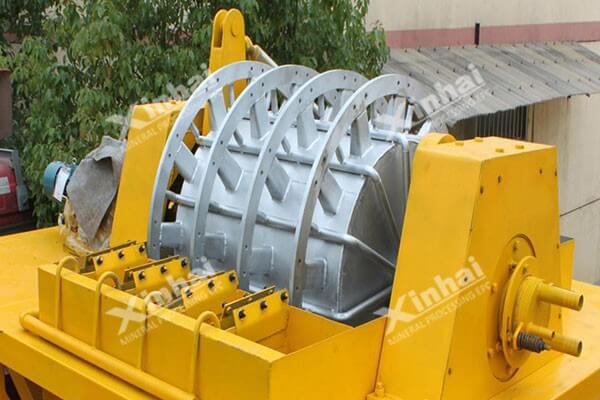
Advantages of the disc vacuum filter:
Low cost, simple structure and small floor space;
The vacuum degree loss is small, and the unit output consumes less power;
Can be used without stirring devices;
It is convenient to replace the filter cloth;
The speed ratio is large, and the transmission is stable and reliable;
The overflow concentration is low, with an average of 32.73%.
Disadvantages of the disc vacuum filter:
There are many problems in the operation of the equipment, and it must be repaired by stopping, which affects continuous production;
The filter cloth is easy to block and wears quickly;
The lower opening is easy to block and needs to be manually dredged;
The filter cake cannot be washed;
Not suitable for handling non-stick materials.
Cylindrical Vacuum Filter
1. External Filter Cylindrical Vacuum Filter
The drum is welded by a perforated steel plate or sieve plate, and a perforated plate of plastic or other material is laid on the outer surface thereof. Dividing the circumference of the drum into a plurality of compartments that are mutually separated, each of the compartments has a filtrate tube communicating with the trunnion of the hollow shaft, the trunnion being connected to the dispensing head, and the filter cloth being wrapped around the perforated plate of the drum. The drum rotates driven by hollow shaft
2. Internal Filter Cylindrical Vacuum Filter
The inner surface of the cylinder of the cylindrical internal filter vacuum filter is its filtering surface. The ore pulp is supplied to the inside of the cylinder, and the coarse material is deposited on the filter cloth before the fine particles due to gravity. A coarse particle layer with a large gap is formed, and as the fine particle material is deposited, a "bridge phenomenon" occurs in the pores, so that fine particles having a diameter smaller than the pores can be stopped, thereby improving the filtration effect.
1. Horizontal Plate and Frame Automatic Filter Press
Structure of Filter Press
Each filter press consists of 6 to 44 vertical plate frames to form 6 to 44 filter press chambers. The inside of the filter plate has a hole for the filtrate and blowing.
The concentration of the filter press is 25%~70%. If necessary, the flotation concentrate with a concentration of only about 30% can be directly supplied to the filter to obtain a concentrate with a water content of 8%. Each press can produce 4.5~5 t filter cake.
Feeding Method of Filter Press
There are three ways to feed the filter press:
Single-stage pump feeding: This method is suitable for the materials with good filtration performance and can be formed into cake under lower pressure;
Two-stage pump feeding: In the initial stage of press filtration, low-pump, high-flow low-pressure pump feed is used,and the pump is replaced after a certain stage. This mode is complicated;
Pump and compressed air machine combined feeding: In this system, a compressed air machine and a storage tank need to be added, so the process is complicated.
Factors Affecting the Operation of the Filter Press
The factors affecting the operation of the filter press are the feed pressure, the concentration of the feed slurry and the composition of the feed size.
If the feeding pressure is higher, the filter driving force is larger, which can reduce the moisture content of the filter cake and increase the processing capacity of the filter press. However, if the feeding pressure is too large, the power consumption would increase, and the equipment would be seriously worn.
For example, with the increase of the content with particle size of -0.074 mm, the processing capacity of the filter press is reduced, and the moisture of the filter cake is increased. Therefore,the dewatering effect is better when the feed particle size is coarse, and a higher capacity and a filter cake with lower moisture content can be obtained.
2. Belt Filter Press
The belt filter press is a continuous filter press with simple structure, convenient operation and good performance.The belt filter press mainly consists of a series of rollers arranged indifferent diameters, two filter belts wrapped around the series of rollers, and a feeding device, a filter cloth cleaning device, a high-speed deviation-adjusting device, a tension device and other components.
The work of the belt filter press consists of four basic processes: flocculation and feeding, gravity dewatering, extrusion dewatering, and unloading and cleaning of the filter belt.
The shape of ceramic filter is similar to disc vacuum filter, which is mainly composed of cylinder, stirrer, scraper assembly, ceramic filter,distributor, vacuum pump, washer, and motor. The basic principle of ceramic filter is also similar to disk vacuum filter which uses porous ceramic filter plate as the filter medium. Under the action of capillary force, only water can pass through the filter plate, and other media cannot pass, thereby achieving the purpose of separation. The specific process is: when the disk with filter plate is immersed in the suspension which is separated under the action of vacuum,the solid material is adsorbed on both sides of the ceramic plate form a filter cake, which is separated from the slurry tank to dewater under vacuum conditions in further removing moisture, and when it reaches a certain position, the filter cake is scraped off by ceramic scraper, at the same time,the remaining solid material on the ceramic plate is removed by back washing,then repeat the above process sequentially
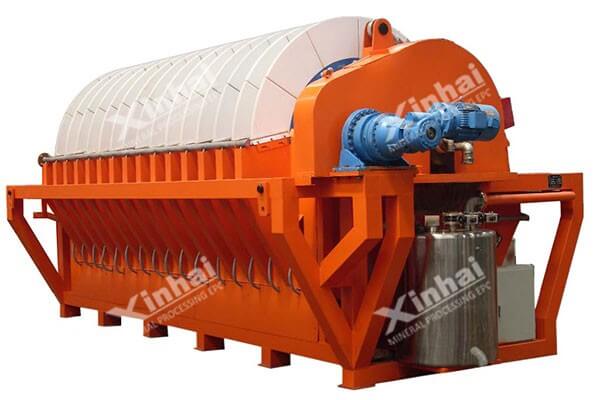
Due to the different structure of different filters, the installation of filter is different. Take the belt filter as an example to illustrate the precautions during the installation of filter:
1. Installation of Filtering Machine
① Civil Construction Requirements:
The level of installation of filter should be easy to operate, maintain and overhaul; the drainage ditch around the filter should have sufficient sectional area and slope to ensure the discharge is smooth when the maximum precipitation flow is possible; there should be a slope drainage ditch with about 3% of the area in a certain area around the filter to ensure that there is no water around the floor of the filter.; the equipment foundation construction is carried out according to the drawings, and the hole size of the anchor screws is ensured to be accurate.
② Installation of Filter Machine:
The filter is generally installed in the whole machine. After it is in place, it must be level-corrected. The concrete in the foot hole is filled to ensure the stability of the filter.
The water filter pipe should be slightly inclined or installed at the lowest point for drainage.
Before installing filter belt, check the connection area between the surface of the chute and each roller and the filter cloth. No burrs, sharp angles or other factors that damage the filter belt are allowed.
The filter belt can be sutured, and the force between any fibers should be consistent when suturing, and the suture should be even and firm.
After the equipment is installed, it is necessary to thoroughly check whether it meets the requirements of the drawings, tighten all the connection screws, inject the bearings into the lubricating oil, and there must be no iron debris between the filter belts.
After the equipment is installed, it is necessary to thoroughly check whether it meets the requirements of the drawings, tighten all the connection screws, inject the bearings into the lubricating oil, and there must be no iron debris between the filter belts
2. Commissioning of Filtering Machine
① Preparation before commissioning:
Check and lubricate all kinds of auxiliary equipment such as slurry pump and liquid medicine metering pump, so that each equipment is in a startable state.
Check that the electrical control box is normal. You should be familiar with the functions of each switch and button before starting for the first time.
Check whether the pipelines such as slurry,liquid medicine and flushing water are unobstructed. The valve should be flexible,not leaking, and closed.
Check the nozzle of the flushing box and the water pipe to install the nozzle to avoid blockage of debris and affect the flushing effect. The pressure gauge of the washing water should be greater than 0.4 MPa.
② Flocculant preparation:
The first time the filter is turned on after the first start or replacement of the filter belt, the pressure reducing valve of the pneumatic system should be closed to unload the fixed value spring.
Check the gas source or the oil pressure gauge display value, the air pressure should be about 0.5 MPa, and the oil pressure should be about 2.5 MPa.
③ No-load operation and load operation test:
The filter belt should be adjusted to a slower speed before running at no load.
No-load operation for 2 h, check the temperature rise of each part; the filter belt works normally, and the automatic adjustment of the deviation is normal before the load test can be carried out.
If the filter is abnormal during no-load operation, stop the inspection immediately.
The load operation test should be carried out for 7 days. During this period, the feed amount, the flocculation dose and the mixing time of the two should be continuously adjusted to adjust the filter belt speed and tension to achieve good dewatering effect.
3. Boot Operation and Adjustment of Filtering Machine
Start the air compressor (or oil pump) and supply compressed air (or pressure oil) to the tensioning and shifting cylinders (or cylinders).
Adjust the pressure reducing valve of the triple piece at the air source to make the pressure to the tensioning and adjusting cylinder reach the working pressure.
Check the filter belt and confirm the normal adjustment of the tension cylinder pressure reducing valve. The initial start can be adjusted to only half of the working pressure. After the main engine is started and the filter belt is completely wet, the air pressure can be adjusted to the test working pressure.
Open the inlet valve, start the pump, and supply the cleaning water. If the water pressure is too low, the main unit cannot start.
Start the belt conveyor.
Start the main machine and adjust the shifting hand wheel of the transmission. The speed of the filter belt can be adjusted to 1.2~1.5 m/min first, and then adjusted to the most suitable belt speed required for the test.
Adjust the pressure reducing valve at the air source so that the output pressure is 0.1~0.3 MPa. Then block the upper and lower filter belts on the left and right sides of the filter belt to observe whether the adjusting roller can work normally and reset. Since the air pressure of the adjusting cylinder increases with the increase of the tension of the filter belt, the air pressure of the shifting cylinder should be adjusted after the air pressure of the tension cylinder is adjusted.
Start the liquid filling motor and stir the flocculant evenly. Start the slurry agitating tank motor, open the dosing valve, start the metering pump, supply the flocculant according to the test data; open the inlet pipe valve, start the slurry pump, supply the slurry according to the test data, and check whether the mixed pulp is in the best flocculation state. Otherwise, the dosage can be adjusted.
Filter belt adjustment. After the new filter belt has been running for a period of time, the filter belt will run of for the speed will become faster and needs to be adjusted.
Adjust other process parameters to keep the filter in optimal working order.
4. Maintenance of Filter Press
① Daily inspection and maintenance items
Filter belt cleaning condition; whether the filter belt is deflected or pleated; whether it is damaged or broken; whether the joint is intact; whether the filter belt tension and flushing water pressure are normal.
The internal cleaning condition of the filter. Whether the flushing device is normal;
Clean up the water in the air compressor,water separator and filter; check the oil level mark, safety valve, pressure regulating valve and filter belt, and clean it if it is blocked.
The funnel of the flocculant device must be cleaned and dried after each use, and the agglomerates on the upper tank and the agitator should be removed in time.
After shutdown, the inlet valve and flocculant outlet valve on the dosing tank should be closed to prevent the flocculant from overflowing.
Check if the drum rotation is flexible and the sludge is attached.
Check the accumulation of solid materials in the water tray and the storage tank, and check whether the water quantity can be guaranteed.
② Weekly inspection items
Check the sealing condition of the slurry pump and the flocculant screw pump, and whether the running sound is abnormal;
Check the flocculant dispensing tank and clean the flow meter and mixer regularly.
Clean and lubricate the guide roller,tension roller and connection part with the specified waterproof grease lubrication pressure gear.
Use high-pressure water to clean the sludge from the gravity dewatering zone, the water tray and the sump.
Check the sealing of the washing pump and check if there is abnormal sound in the head.
③ Weekly maintenance items
The flocculant dispensing tank should be cleaned at least once a month and once a week if necessary.
Calibrate the screw pump and its operation.
Correct the working condition of the air compressor, and its inflation time should meet the specifications.
Check the functions and protection functions of the control cabinet.
④ Quarterly maintenance items
All roller bearings must be replaced with grease every three months. The externally mounted bearings use normal grease and the inner mounted bearings use waterproof grease.
⑤ Annual maintenance items
Replace the lubricant in the gearbox.
Replace the oil in the air compressor.
The operation steps of the plate filter press are divided into four steps:
1. Pressing
Before the filter press is operated, it is necessary to check the whole machine. For example, check whether the filter cloth is folded or overlapped, and whether the power supply is connected normally. After the inspection is correct, the pressing operation can be performed. First press the “Start” button, the oil pump starts to work,and then press the “Pressing” operation, the piston pushes the pressing plate to press, and when the pressure reaches the set high pressure, the hydraulic system automatically stop.
2. Feeding
Turn on the feed pump and slowly open the feed valve and the feed pressure rises to normal pressure. At this time, observe the liquid output of the filter press and the penetration between the filter plates. After filtering for a period of time, the liquid output from the press outlet is gradually reduced until no liquid is discharged or the liquid is discharged very little, indicating that the filter residue in the filter chamber is completely filled and a filter cake is formed.
3. Washing or Air Drying
After the filter cake is filled,the feed pump and the feed valve are closed, the washing pump or the air compressor is turned on, the washing liquid or the air inlet valve is slowly opened, and the filter cake is washed or air-dried. Close the washing pump or air compressor and its valve after the operation is completed.
4. Unloading cake
First close the feed pump and feed valve, the feed liquid or the air inlet device and the valve,then press the “Release” button on the operation panel, and the piston rod will drive the pressure plate back. When the piston rod is retracted to the proper position, it is loosened and the filter plate is manually pulled one by one to remove the filter cake. At the same time, the filter residue at the sealing surface is cleaned to prevent the filter residue from affecting the performance of the sealing surface
The operation steps of belt filter press includes the following four stages:
1. Flocculation feeding stage
Although the belt filter press has two filter belts disposed opposite, the horizontal direction is not sealed, and the slurry may flow out from both sides of the filter belt. Therefore, when a belt filter press is used, the slurry is necessarily taken the pre-chemical flocculation. The type and dosage of flocculant are determined according to the nature of the treated material. In the belt filter press, solid particles are not completely trapped by the filter belt, but are closely related to the flocculation effect of slurry.
2. Gravity dewatering stage
For most belt filter presses, gravity dewatering refers to adding flocculated slurry to a horizontal or nearly horizontal filter belt. When the filter belt is in operation, due to the effect of gravity, most free water in flocculated slurry can be removed. The semi-filter cake slurry formed in gravity dewatering stage should be able to withstand the squeeze of filter belt and roller without loss, and the gravity dewatering zone should not be too short, generally up to 2.5-2.7 m.
3. Squeeze and dewatering stage
The filter cake formed by the gravity dewatering stage needs to be further dewatered by low pressure dewatering and high pressure dewatering. Low-pressure dewatering is achieved by the pressure of upper and lower filter belts and rollers that are gradually reduced in pitch. The movement direction of the filter belt is generally changed once it passes through a roller wheel, so as to make the particles to be misaligned and sheared, which is helpful for the dehydration process. After low pressure dewatering, the filter cake enters a high-pressure dewatering stage. At this time, it is bent and operated between a plurality of press rolls and is subjected to further squeeze and dewater, and finally a combined filter cake is formed.
4. Unloading and filter belt cleaning stage
After the filtration is finished, the upper and lower filter belts start to separate,and the filter cake is separated from the filter belt by the bending,self-weight and scraper of filter belt, and the unloaded filter belt needs to be cleaned before entering the next working cycle. At present, the high pressure water cleaning filter belt method is generally used.
1. Filter cake formation and dewatering
The filter cake is rapidly formed while the filter plate is dewatering from the suspension through vacuum. After the filter plate is rotated away from the suspension, the vacuum-pumping continues, further removing the water from the filter cake and drying the filter cake..
2. Filter cake scraping
The dried filter cake is scraped off by scraper and dropped onto the conveyor belt
3. Backwash
After the filter cake is scraped off, a thin layer filter cake is still left between filter disc and scraper, and it is washed with backwash to remove it off.